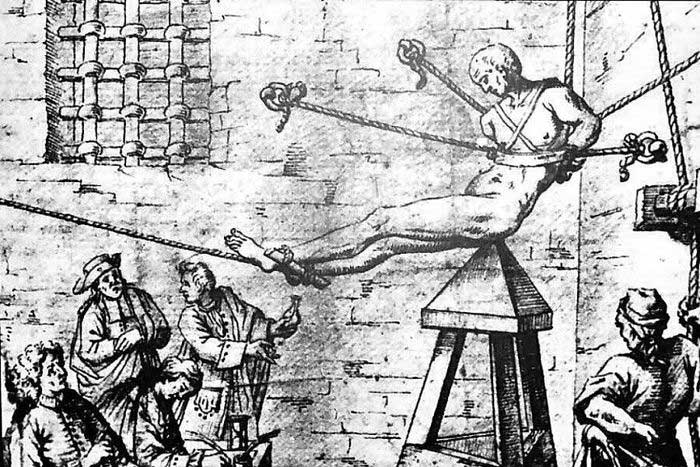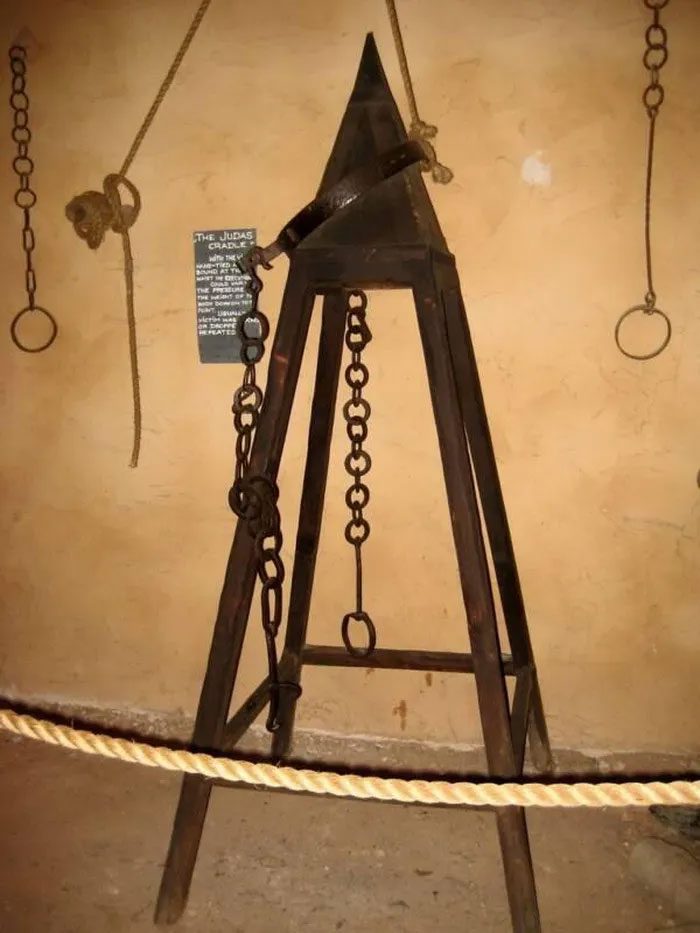The Judas Chair Dates Back to the Spanish Inquisition (1542 – 1834). At first glance, the chair may not seem impressive, but it heralds a terrifying fate for anyone unfortunate enough to fall onto its sharp, pointed tip.
According to allthatsinteresting, the Spanish Inquisition was a period marked by unprecedented and brutal torture methods.

Illustration of a prisoner being tortured by the Judas chair. (Image: allthatsinteresting).
In fact, some of the most infamous torture methods in history were employed by inquisitors of the time to punish those accused of crimes, including devices like racks, wheels, and water torture. However, a lesser-known torture method favored by the Spanish was the Judas chair. Strangely enough, they regarded the Judas chair as one of the more humane forms of torture.
The Judas chair itself is not particularly elaborate. It consists of a wooden pyramid placed atop three or four wooden chair legs. The Judas chair resembles a stool, but it’s safe to say that no one would want to sit on it. The chair is positioned in a corner of the torture room, and the victim is suspended above it, slowly lowered onto the sharp tip of the pyramid, sometimes with additional weights strapped to their body.
The Spanish Inquisition (a court established to try those deemed heretical by the authorities) used this chair for torture, but it was originally conceived by an Italian lawyer named Hippolytus De Marsiliis, also known as Ippolito Marsili. Notably, Marsili was also the one who introduced water torture.
Marsili studied law in Bologna alongside other notable figures such as Andrea Barbazza, Vincenzo Paleotti, and Alberto Cattani, later becoming a favored pupil of Felino Sandeo, who held the position of chair of canon law in Ferrara and Pisa for a time.
Marsili himself earned a doctorate in utroque iure (a doctorate in civil and ecclesiastical law) in 1480. Two years later, he obtained a chair in civil law and subsequently became an advisor to Antonio Burgos and Paolo d’Oria. Throughout his career, Marsili had numerous students and delivered countless lectures, many of which he recorded in books.
However, Marsili is perhaps best known for the various torture methods he devised. Many judges of his era had a tendency to favor torture, and although he regarded it as a last resort rather than entertainment, his intellect gave rise to some of the most brutal torture techniques.
For instance, water torture was conceived after observing how water eroded parts of stone. Additionally, there were measures that forced victims to remain awake while seated on the chair, with some prisoners being kept awake for as long as 40 hours.
Of course, Marsili also invented the Judas chair. The reasons or circumstances that led Marsili to come up with the idea for the Judas chair remain unclear. Perhaps Marsili and his fellow church law scholars spent a great deal of time brainstorming torture techniques, and the Judas chair was merely a result of that process.
Marsili considered many of his torture techniques to be humane. Even the Judas chair was intended to keep a person alert and prevent them from sleeping. However, those who implemented the Judas chair found ways to further torment their victims.
Despite being a method that Marsili deemed humane, the infrequency of cleaning the wooden pyramids by torturers led many prisoners to die from infections caused by dried blood and residual feces.
During the time Marsili developed his “humane” torture techniques, other members of the Spanish Church were employing many torture methods they had learned over the years.
There were few basic rules for the inquisitors, meaning they were free to extract information whenever and however they wished. In fact, the Grand Inquisitor Tomás de Torquemada advanced his career through his cruelty and subsequently wielded his power to expel over 160,000 Jews from Spain.

A Judas chair on display in a museum. (Image: Twitter).
Additionally, any Jews or Muslims who remained and converted were immediately targeted by Torquemada and his inquisitors. Most believed that those who converted to Christianity did so for insincere reasons. Instead, Torquemada believed many converted merely out of fear of death.
Although Torquemada was one of the most brutal inquisitors, personally overseeing 2,000 executions during his tenure, he was hardly the only one meting out harsh punishments to those deemed heretical.
According to the Encyclopedia Britannica, until the mid-18th century, the Spanish Inquisition continued to hunt, convict, and execute people using Torquemada’s preferred method: auto-da-fé, which means “act of faith.” Essentially, this was a form of burning someone alive to compel them to confess their sins. It goes without saying that most people did not survive, even if they confessed.
However, alongside this, Spanish inquisitors frequently employed other brutal forms of torture, such as the Spanish donkey, racks, knee splitters, and of course, the Judas chair.
Like many ancient torture devices, visitors to the Torture Museum in Spain can see what the Judas chair looked like. In fact, the museum features two different models on display: one model that resembles a small pyramid attached to four legs at each corner, and another model with the pyramid sitting atop a sharp point, resembling an arrow on four chair legs.
The Judas chair is undoubtedly one of the most horrifying torture methods in history, but ironically, it was considered relatively humane at the time.


















































